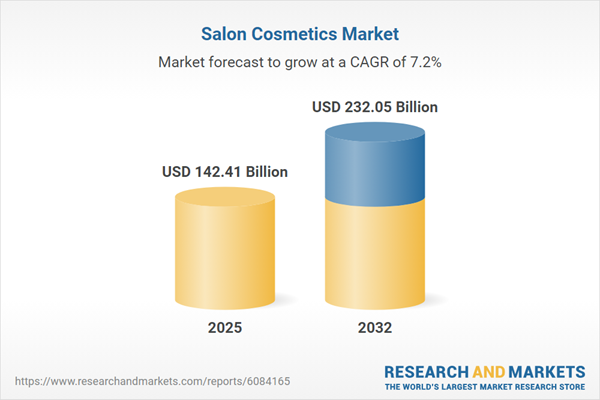Speak directly to the analyst to clarify any post sales queries you may have.
The salon cosmetics market is undergoing dynamic transformation as innovation, changing consumer behaviors, and sustainability pressures drive new investment and operational strategies across the professional beauty landscape.
Market Snapshot: Salon Cosmetics Market Size and Growth
The Salon Cosmetics Market grew from USD 132.79 billion in 2024 to USD 142.41 billion in 2025. It is projected to expand at a CAGR of 7.22%, reaching USD 232.05 billion by 2032. Strong growth is supported by evolving service expectations, product innovation, and strategic adaptation to shifting regulatory and operational environments. Senior leaders benefit from an up-to-date view of the professional cosmetics value chain, which underpins both long-term planning and responsiveness to immediate market challenges.
Scope & Segmentation: Salon Cosmetics Industry Overview
The research provides comprehensive segmentation and expansive industry coverage. Segmentation insights include:
- Product Types: Hair care (conditioner, shampoo, treatments), colorants (permanent, semi-permanent, temporary), nail care (manicures, nail treatments, pedicures), skin care (body, facial, treatment), and styling products (gels, sprays, waxes).
- Distribution Channels: Offline and online retail touchpoints, with robust omnichannel strategies combining in-person and e-commerce journeys.
- End Users: Beauty institutes, chain salons, home users, independent salons, and spas, each with distinct procurement and service requirements.
- Price Tiers: Economy, mid-range, and premium offerings, delineating diverse consumer access points and supporting tailored brand positioning.
- Regional Reach: Coverage spans Americas (North America, Latin America), Europe, Middle East, Africa, and Asia-Pacific, reflecting the interplay between established markets and emerging corridors of growth.
- Leading Companies: Profiles include L’Oréal S.A., Coty Inc., Henkel AG & Co. KGaA, Kao Corporation, Shiseido Company, Amorepacific Corporation, Revlon Inc., Wella Company GmbH, John Paul Mitchell Systems, and Olaplex Inc.
Key technology themes include digital diagnostics, virtual try-on tools, green chemistry, and advanced packaging, which collectively shape innovation and enable enhanced consumer experiences.
Key Takeaways: Strategic Insights Driving Market Leadership
- Professional beauty providers are adapting by blending traditional skills with digital engagement, fostering highly differentiated in-salon service models aligned to evolving preferences.
- Clean beauty, ingredient transparency, and sustainable packaging are critical drivers, compelling brands to prioritize eco-friendly materials and formulations.
- The integration of omnichannel retail strategies ensures seamless brand experiences, linking online consultations and in-salon activations to build customer loyalty and boost retention.
- Advances in biotech and cross-category collaboration enhance the ability to serve diverse consumer groups, with product innovation focusing on personalization and inclusivity.
- Strategic partnerships, targeted capital allocation, and data-driven supply chain management strengthen market positions amid rising complexity.
Tariff Impact: Navigating Policy Changes in Supply Chains
New United States tariff measures are influencing supply chains and cost structures for salon cosmetics. Companies are prioritizing local supplier development and near-shoring to maintain supply continuity and manage increased expenses. This environment encourages agile procurement, proactive stakeholder communication, and strengthened value chain partnerships to address volatility and ensure long-term operational resilience.
Methodology & Data Sources
This report combines primary research—executive interviews and stakeholder insights—with secondary data, including trade publications, regulatory filings, and proprietary databases. Quantitative findings are validated through rigorous triangulation, statistical audits, and periodic peer review. The approach ensures robust, reliable analysis for salon cosmetics market intelligence.
Salon Cosmetics Market: Why This Report Matters
- Decision-makers gain actionable insight to inform portfolio strategies, operational planning, and targeted investment in the evolving salon cosmetics sector.
- The analysis highlights the intersection of innovation, consumer trends, and regulatory factors, empowering organizations to identify resilient growth opportunities and mitigate emerging risks.
- Clear segmentation and geographic detail support precise market entry and expansion strategies for global and regional players alike.
Conclusion
This report equips industry executives with comprehensive, reliable intelligence to anticipate change and capture value in the changing salon cosmetics marketplace. The insights enable strategic responses and sustained competitive advantage in a rapidly evolving sector.
Table of Contents
3. Executive Summary
4. Market Overview
7. Cumulative Impact of Artificial Intelligence 2025
Companies Mentioned
The companies profiled in this Salon Cosmetics market report include:- L’Oréal S.A.
- Coty Inc.
- Henkel AG & Co. KGaA
- Kao Corporation
- Shiseido Company, Limited
- Amorepacific Corporation
- Revlon, Inc.
- Wella Company GmbH
- John Paul Mitchell Systems, LLC
- Olaplex, Inc.
Table Information
| Report Attribute | Details |
|---|---|
| No. of Pages | 184 |
| Published | October 2025 |
| Forecast Period | 2025 - 2032 |
| Estimated Market Value ( USD | $ 142.41 Billion |
| Forecasted Market Value ( USD | $ 232.05 Billion |
| Compound Annual Growth Rate | 7.2% |
| Regions Covered | Global |
| No. of Companies Mentioned | 11 |









